
I will never forget when I became hooked on butterflies. It was 2007, my first year working at Powell Gardens in Kingsville, Missouri. Each spring the garden includes milkweeds (Asclepias spp. and cvs., Zones 3–11) in the planting lineup for its annual Festival of Butterflies, and by summer the plants are covered with monarch caterpillars. That first year, I was completely mesmerized by all the caterpillars and butterflies. To this day, I still get excited during butterfly season and look forward to seeing how much the caterpillars have eaten and grown from one day to the next.
Without a doubt, butterflies are among some of the most beloved and fascinating creatures on the planet. At the same time, their ecological role as pollinators is critical to the planet’s environmental health. With natural habitats disappearing, it has become increasingly more important to make our gardens, yards, and neighborhoods more butterfly friendly. Doing so is more than just planting pretty flowers. To feed and thrive, butterflies require both host plants that supply foliage for caterpillars and a succession of nectar-rich blooms from spring to fall for the adults.
Host plants that provide caterpillar food and shelter
When it comes to supporting butterflies and attracting them to your yard, the most significant thing to have is a variety of host plants. These are plants that a butterfly will lay eggs on and that the caterpillars will eat. Different butterfly species prefer different host plant species, so it is important to do your homework and find out which butterflies live in your area and which host plants they favor. The following are among my favorite choices for host plants that support butterflies found across much of North America.
Sweet bay magnolias are fragrant semievergreen trees

Magnolia virginiana and cvs.
Zones: 5–10
Size: 10 to 35 feet tall and wide
Conditions: Full sun to partial shade; fertile, moist, well-drained soil
Native range: Eastern United States

Host plant for: Eastern tiger swallowtail
Sweet bay magnolias are like candy for the eastern tiger swallowtail, a butterfly that likes to fly high and lay eggs at the top of its host plant (which can make finding eggs or caterpillars challenging). They can grow as semi-evergreen multistemmed trees but also can be trained as single-trunked specimens. The glossy foliage is accompanied by fragrant creamy-white blooms in mid to late spring, depending on the timing of the last frost. After flowering, red berries appear and attract other wildlife looking for a snack. The straight species can reach considerable size over time; however, many selections mature to only around 20 feet tall.
Common milkweed takes hot and dry like a champ
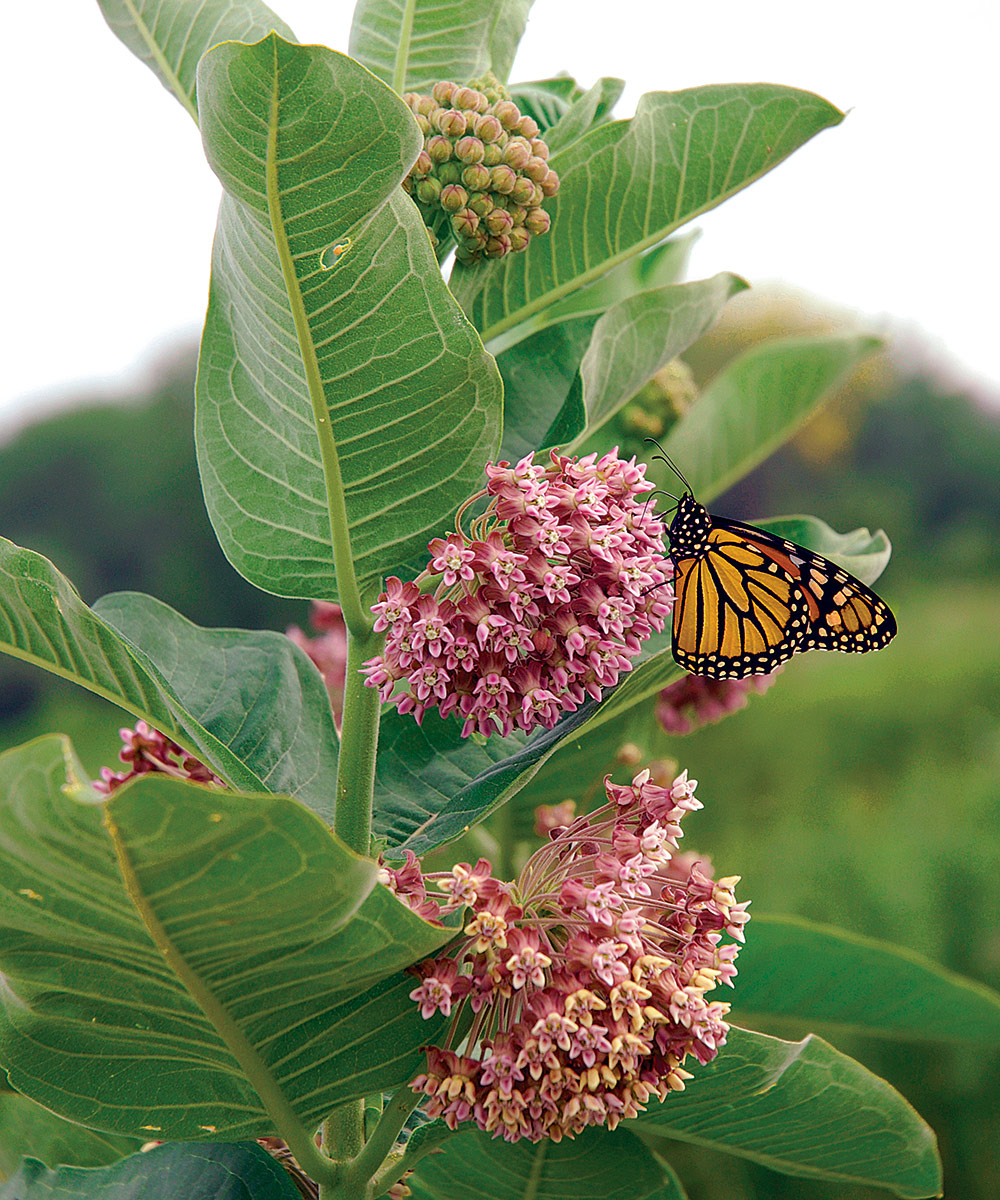
Asclepias syriaca
Zones: 3–9
Size: 24 to 48 inches tall and 9 to 12 inches wide
Conditions: Full sun; fertile, well-drained soil
Native range: Eastern North America

Host plant for: Monarch
Commonly found along highways and in fields, this milkweed is a favorite host plant among monarch caterpillars for its large oval leaves. The mauve pink flowers are also a valuable nectar source for adult butterflies in summer. This perennial spreads rapidly by creeping rhizomes and can reach up to 6 feet tall in places where it is especially happy. Be sure to put it in a place where it can expand and naturalize. If plants start to look less desirable in summer, cut them back to encourage a fresh flush of regrowth—but make sure you look for eggs (tiny white ovals) and caterpillars first, both of which are found on the newest growth on the underside of the leaf. Common milkweed loves it hot and dry but will also happily grow in most soil conditions.
Spicebush thrives in shadier nooks and crannies

Lindera benzoin
Zones: 4–9
Size: 8 to 18 feet tall and wide
Conditions: Partial shade; fertile, moist soil
Native range: Eastern United States

Host plant for: Spicebush swallowtail
It probably comes as no surprise that spicebush is an important host plant for spicebush swallowtail. You can find the larvae by looking for “leaf tacos.” These are created from the caterpillar’s silk, which causes the foliage to fold over on itself. The caterpillars sit inside their leaf tacos when not eating. This shrub can grow up to 18 feet tall and features small yellow flowers in spring, which are followed by little red berries. The leaves of the spicebush are very fragrant when crushed or even brushed against. This plant prefers afternoon shade. Too much sun will inhibit growth, so keep it out of the line of fire of scorching afternoon light. If you would like to manage size or encourage more shrubby growth for caterpillars to enjoy, spicebush responds well to periodic coppicing.
Yin® David viburnum feeds both caterpillars and adult butterflies
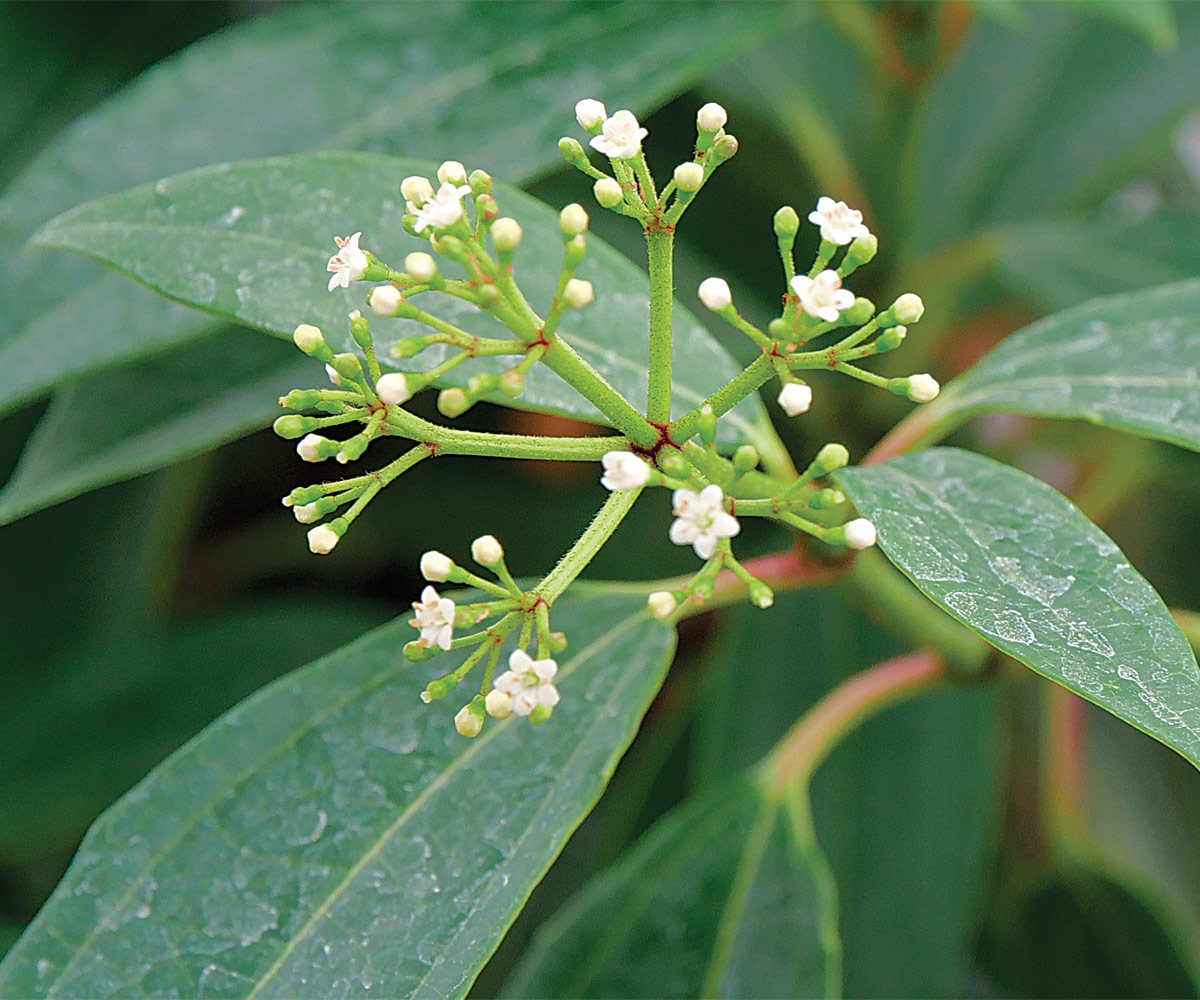
Viburnum davidii ‘NCVX2’
Zones: 7–9
Size: 2 to 4 feet tall and 4 feet wide
Conditions: Full sun to partial shade; moist, well-drained soil
Native range: China

Host plant for: Hummingbird moth
This viburnum is a handsome shrub that serves as both host plant and nectar source. Although technically not butterflies, those cute little hummingbird moths use this plant as a host. The spring azure butterfly also feeds on the nectar of Viburnum species. This specific cultivar of viburnum was bred to be more heat tolerant than other varieties and has attractive foliage all year round. It is a female selection that features white flowers in spring, followed by bright blue berries if a male counterpart such as Yang® David viburnum (V. davidii ‘NCVX3’, Zones 7–9) is planted nearby. Even though it is only hardy in warmer climates, Yin® David viburnum can be grown in containers and brought inside for the winter in colder regions.
Hop tree is a great choice for understory locations

Ptelea trifoliata
Zones: 4–9
Size: 15 to 20 feet tall and wide
Conditions: Full sun to partial shade; moist, well-drained soil
Native range: North America
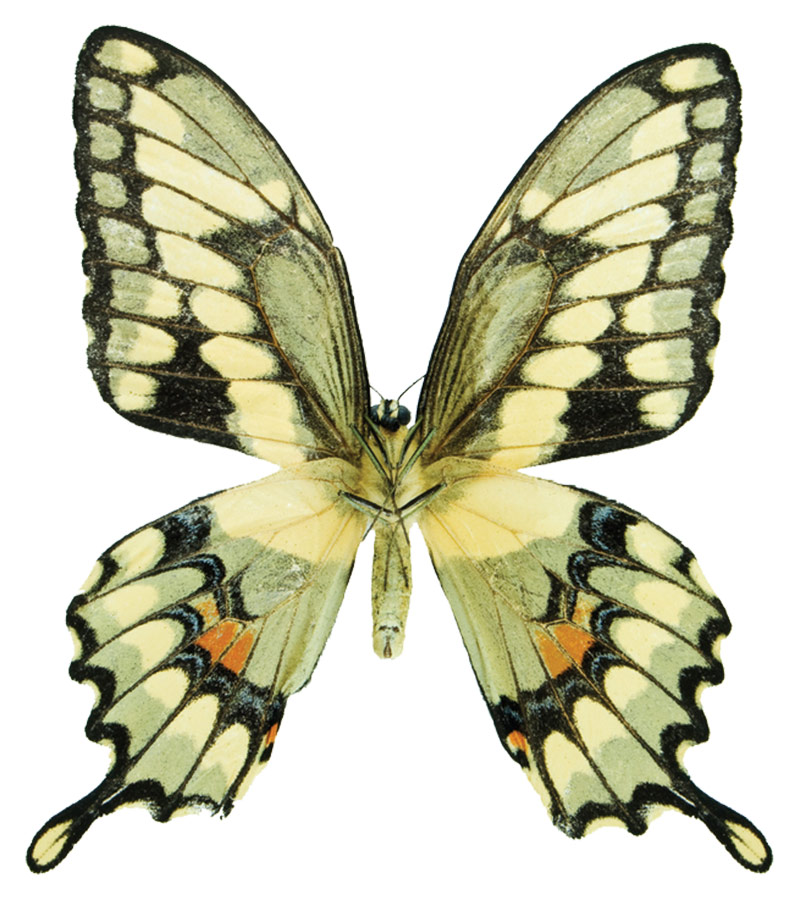
Host plant for: Giant swallowtail
This medium-size native grows to form a small tree or large shrub with attractive, but unpleasant smelling, whitish green flowers in early summer. The blooms are followed by clusters of wafer-like seedpods. An excellent host plant for the giant swallowtail (North America’s largest butterfly) and eastern tiger swallowtail, hop tree typically grows as an understory plant, where it prefers to receive diffused light below a higher tree canopy. However, it will grow in full sun if the summer is not brutal. Hop tree needs to be watered during dry summers to keep its leaves from getting crispy. It is also another good candidate for coppicing to reduce size and to promote bushier growth (and more leaves for caterpillars to feed on).
Blooms that supply butterflies with nectar at different times of the year
Adult butterflies need flower nectar to sustain themselves in spring, summer, and fall. While many butterflies thrive and are seeking nectar in the warmer months, there are butterflies that do so in the cooler months also. So it is imperative to have blooming plants that provide nectar in your garden throughout different times of the year.
To indicate that your garden is open for business, choose a mix of plants that creates a broad welcome mat of color. As butterflies fly from one area to another, they are looking for vibrant hues and are less concerned about specific plant species (unlike their choice of host plants). Here are some stellar nectar sources that vary in size and that provide butterfly-attracting flower color at different times of the gardening season.
‘Totally Tangerine’ geum serves up a supply of spring nectar
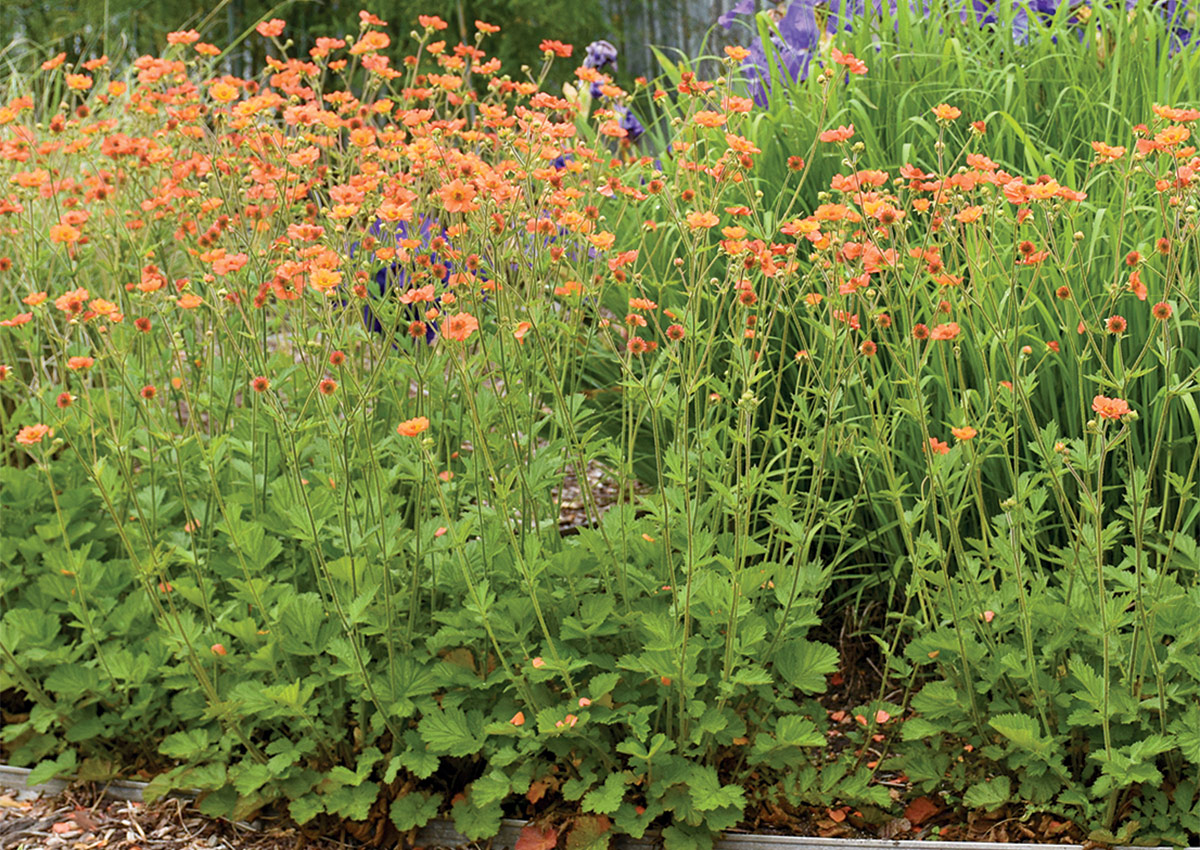
Geum ‘Totally Tangerine’
Zones: 4–7
Size: 14 to 30 inches tall and 18 inches wide
Conditions: Full sun to partial shade; fertile, moist, well-drained soil
Native range: Europe, South America
Bloom time: Midspring through summer
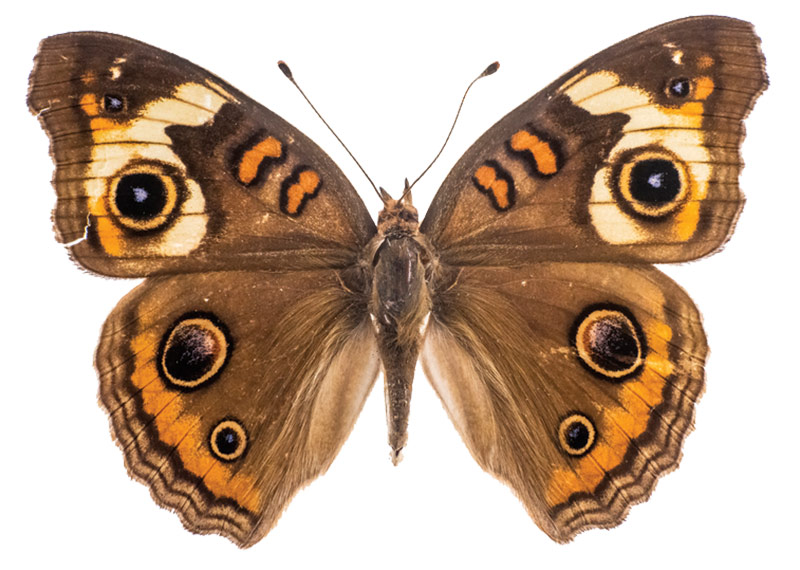
Commonly attracts: Common buckeye
This beautiful orange-blooming perennial is a good choice for a pop of spring color. The large, sterile flowers will keep going until the summer heat really sets in. Keeping this plant deadheaded will extend the show, encouraging even more blooms. ‘Totally Tangerine’ geum remains a nice tidy clump all through the growing season, so it is pretty low maintenance when placed in a spot with enough sunlight and average soil.
‘Cheyenne Spirit’ coneflower is a good choice for sun and droughty conditions

Echinacea ‘Cheyenne Spirit’
Zones: 4–9
Size: 12 to 30 inches tall and 12 to 24 inches wide
Conditions: Full sun to partial shade; fertile, moist, well-drained soil
Native range: North America
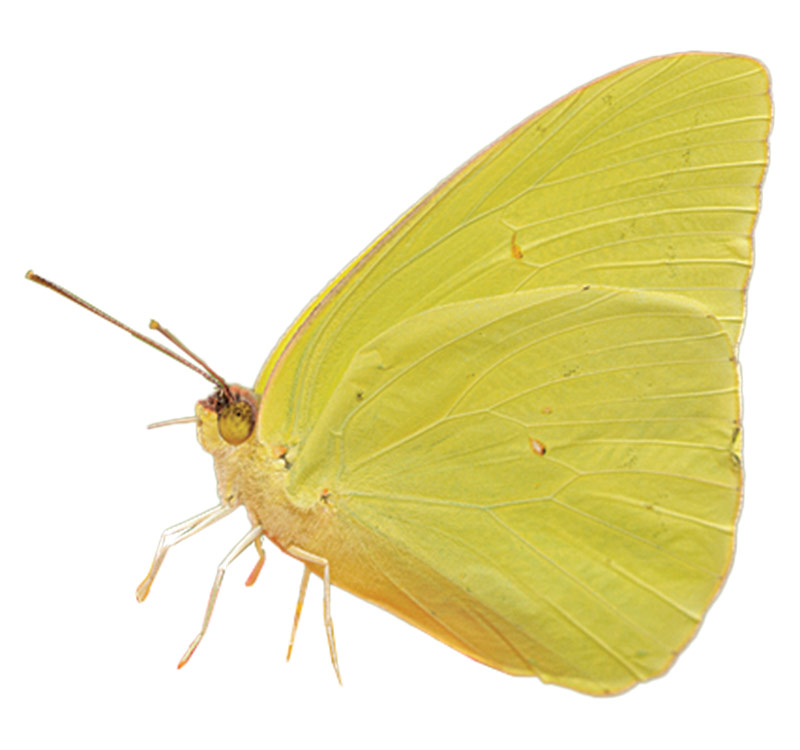
Bloom time: Summer into fall
Commonly attracts: Cloudless sulphur
This hybrid coneflower includes yellow, orange, and red flowers that bloom earlier than most coneflowers. It also stays more compact and holds up better in high winds. It does well in containers too. Like straight species of native coneflowers, ‘Cheyenne Spirit’ can handle hot sun and drier conditions. A very reliable perennial, it’s also easy to start from seed every year— and will bloom a few months after sowing.
‘Bumblesnow’ meadow salvia dazzles with unique white blooms
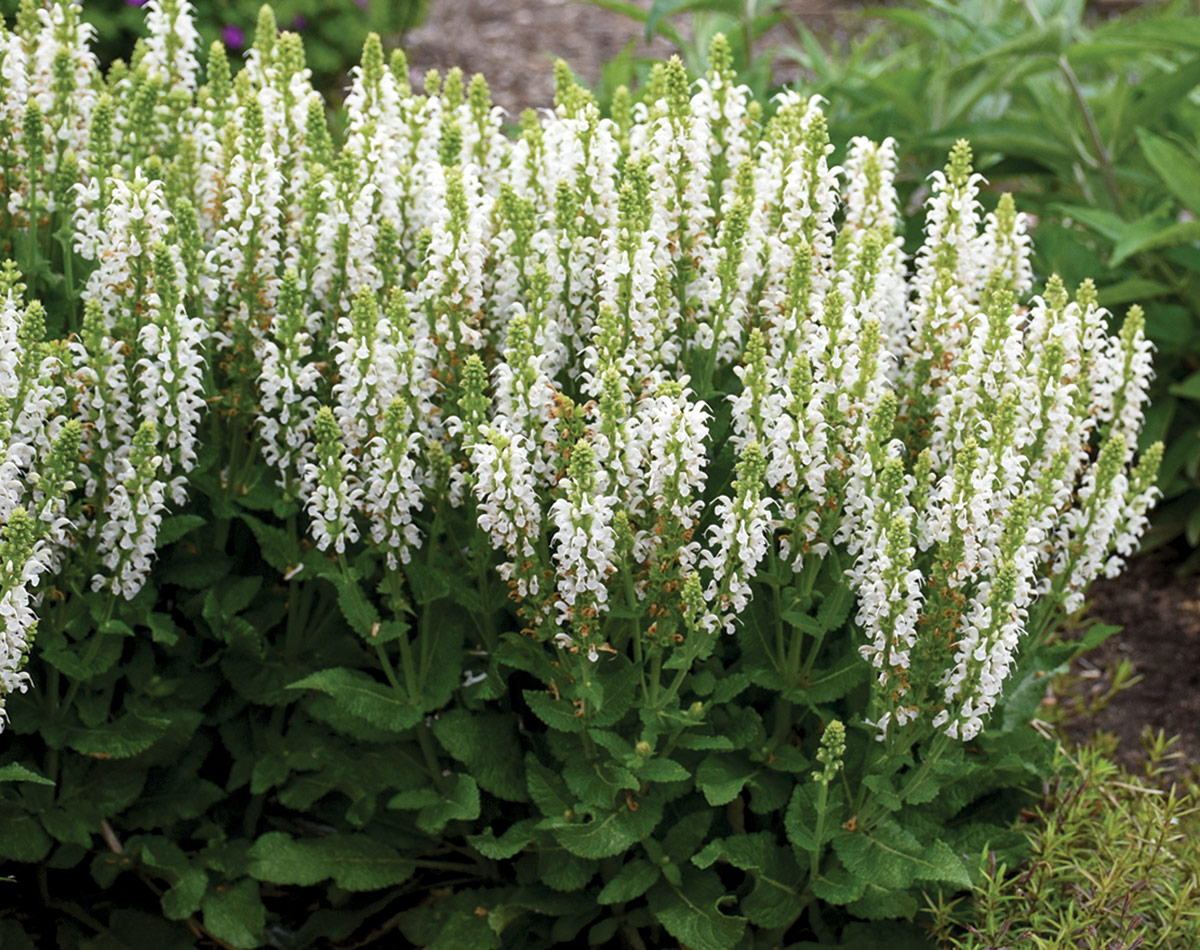
Salvia nemorosa ‘Bumblesnow’
Zones: 4–8
Size: 10 to 12 inches tall and 12 to 14 inches wide
Conditions: Full sun; average, well-drained soil
Native range: Asia, Europe
Bloom time: Early summer

Commonly attracts: Red admiral
This perennial meadow salvia is a great early-blooming choice for butterflies seeking nectar earlier in the gardening season. Its snow-white blooms are a lovely departure from the typical purple to violet-blue flowers of this species. Once the first blossoms have faded, give ‘Bumblesnow’ a good deadheading; a new flush of flowers should appear. Its diminutive size makes it a good front-of-the-border plant. It also works well in containers.
‘Baby Joe’ Joe Pye weed is well suited for moist areas
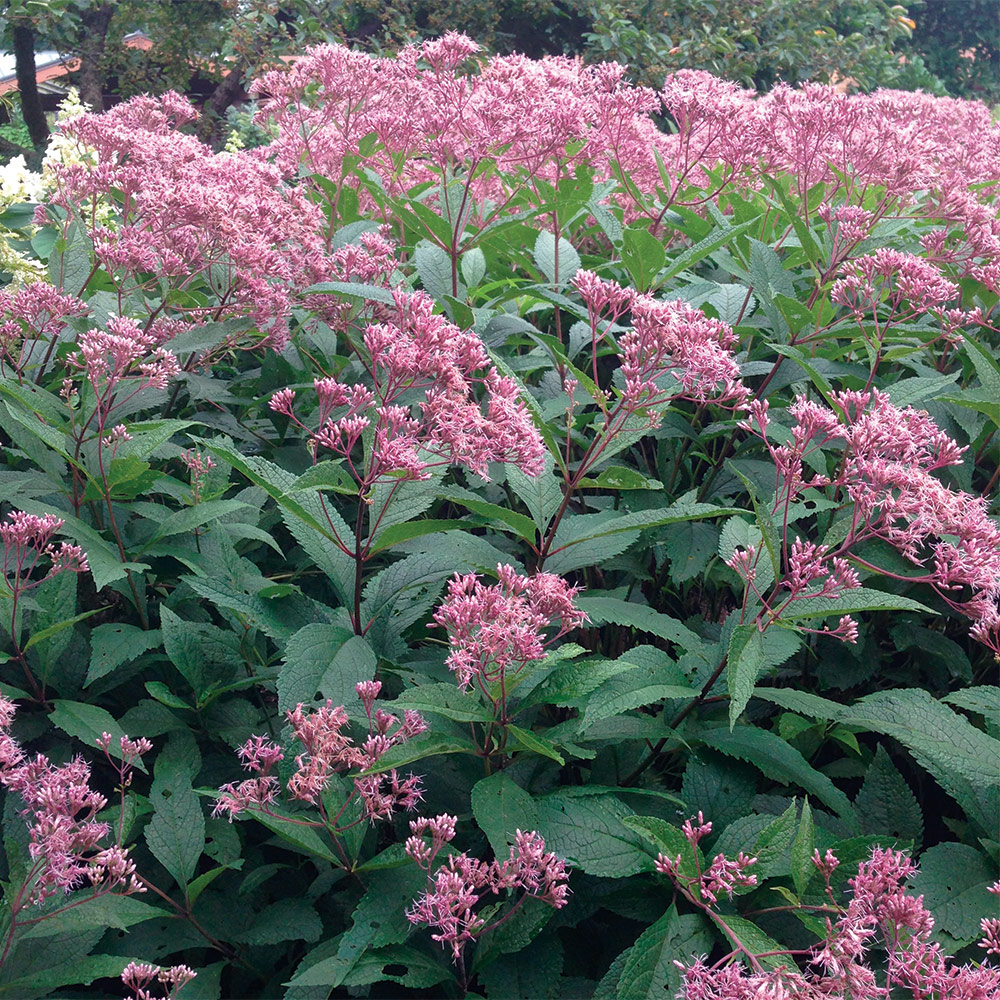
Eutrochium dubium ‘Baby Joe’ (syn. Eupatorium dubium ‘Baby Joe’)
Zones: 3–9
Size: 2 to 3 feet tall and 1 to 2 feet wide
Conditions: Full sun to partial shade; moist, well-drained soil
Native range: Eastern North America
Bloom time: Midsummer to early fall

Commonly attracts: Eastern tiger swallowtail
Joe Pye weeds are butterfly magnets when they are in bloom. Native to moist thicket and sandy riverside habitats, E. dubium typically grows to 6 feet or taller. ‘Baby Joe’, however, only reaches 3 feet tall, which makes it a more appropriate choice for most garden locations. Just be sure to provide it with ample space to eventually spread and naturalize. Also, keep in mind that Joe Pye weed likes a good amount of moisture, so it will need to be watered frequently during dry spells. You will know the extra effort was well worth it when you see butterflies enjoying the nectar from this cultivar’s abundant dark pink blooms.
The life cycle of a butterfly

The journey from egg to adult butterfly is truly extraordinary. It starts with a female butterfly laying eggs on a specific host plant that she knows the caterpillar will eat. Females find these plants by using tiny sensors on the bottom of their feet, like the taste buds on your tongue. Eggs are typically laid on the newer leaves because it is easier for a small caterpillar to eat fresh, softer leaves. It takes an egg 3 to 5 days to hatch; once a caterpillar chews its way out of the egg, it eats its eggshell for its first meal.
After that, all the caterpillar needs to worry about is eating. Over the next 7 to 10 days, the caterpillar will shed its skin five times. A caterpillar grows like a snake, shedding skin to have more room in its body to continue eating. When it gets close to its fifth molt, it finds a protected place to make its chrysalis. Then it sheds its skin one more time and the chrysalis is formed. After a few hours, the chrysalis hardens a bit and becomes ready to start the transformation inside. After another 7 to 10 days, the butterfly is ready to emerge from the chrysalis. Once that happens, the butterfly is ready to feed on flower nectar and find a mate to start the process all over again.
How they defend against predators

Butterfly larvae (caterpillars) are highly vulnerable to predators such as other insects, amphibians, small mammals, and especially birds. Hiding in plant foliage is one way they prevent themselves from being eaten. Some caterpillars also produce chemical defenses so that they taste unpleasant or are even toxic to other wildlife, while others have evolved their appearances to have features like markings that look like big scary eyes (left photo) or to resemble unappetizing bird droppings (right photo).
Eric Perrette is a lead horticulturist at Powell Gardens in Kingsville, Missouri, and has expertise in native butterflies and their habitats.
Sources
- Bluestone Perennials, Madison, OH 800-852-5243; bluestoneperennials.com
- Nature Hills Nursery, Omaha, NE 402-934-8116; naturehills.com
- Prairie Nursery, Westfield, WI 800-476-9453; prairienursery.com
- Sooner Plant Farm, Park Hill, OK 918-453-0771; soonerplantfarm.com
Fine Gardening Recommended Products

Gardener's Log Book from NYBG
Fine Gardening receives a commission for items purchased through links on this site, including Amazon Associates and other affiliate advertising programs.

The Nature of Oaks: The Rich Ecology of Our Most Essential Native Trees
Fine Gardening receives a commission for items purchased through links on this site, including Amazon Associates and other affiliate advertising programs.

A.M. Leonard Deluxe Soil Knife & Leather Sheath Combo
Fine Gardening receives a commission for items purchased through links on this site, including Amazon Associates and other affiliate advertising programs.


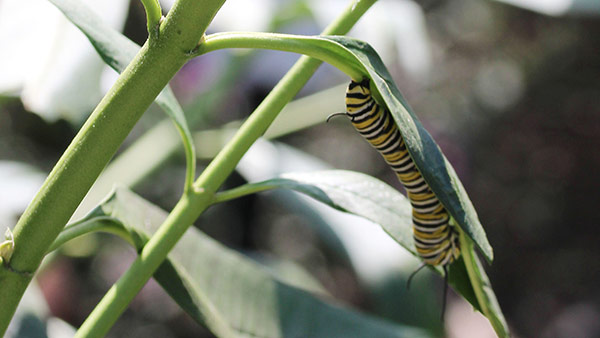

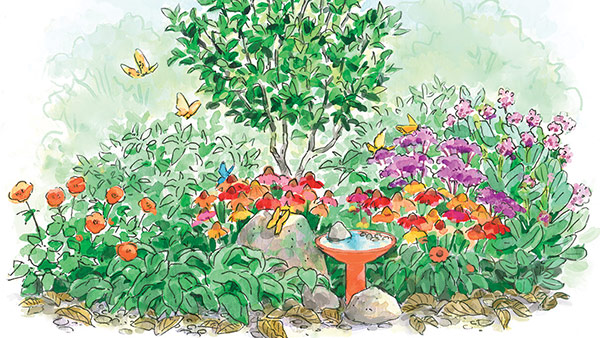














Comments
In a certain aspect, it can be said that between flowers and butterflies G Switch with support and symbiosis for each other. The butterflies are extremely beautiful.
Log in or create an account to post a comment.
Sign up Log in